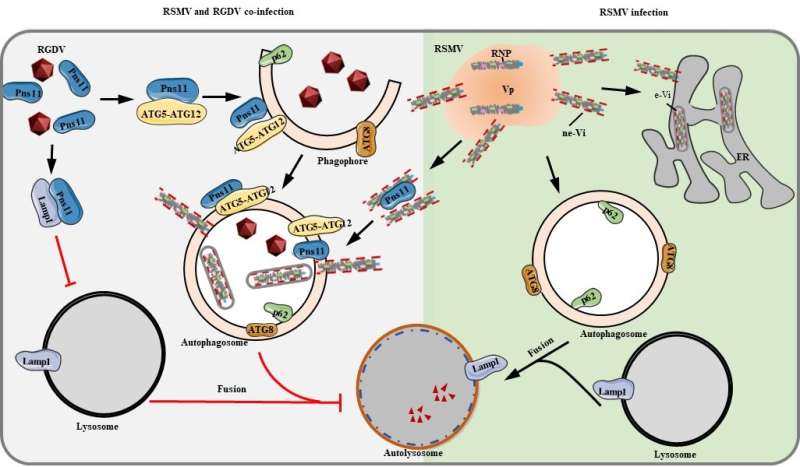This article has been reviewed according to Science X's editorial process and policies. Editors have highlighted the following attributes while ensuring the content's credibility:
fact-checked
peer-reviewed publication
trusted source
proofread
Autophagy mediates a direct synergistic interaction during co-transmission of two arboviruses by insect vectors

Multiple viral infections in insect vectors with synergistic effects are common in nature, but the underlying mechanism remains elusive. A new study, published in Science China Life Sciences and led by Dr. Taiyun Wei (Institute of Vector-borne Virus Research Center, State Key Laboratory of Ecological Pest Control for Fujian and Taiwan Crops, Fujian Agriculture and Forestry University), looked more closely at a mosaic virus and its transmission by leafhoppers.
Last year, the team reported the rhabdovirus rice stripe mosaic virus (RSMV) was transmitted together with the reovirus rice gall dwarf virus (RGDV) and the co-infection significantly promoted the propagation and transmission efficiencies of RSMV by leafhopper vector Recilia dorsalis in the field.
However, the underlying mechanism remained elusive. Recently, the team found that RSMV nucleoprotein (N) alone activated complete anti-viral autophagy, while RGDV nonstructural protein Pns11 alone induced incomplete autophagy to promote viral propagation in leafhopper vectors. Interestingly, RSMV exploited Pns11-induced autophagosomes to assemble enveloped virions via N-Pns11-autophagy-related protein 5 (ATG5) interaction in co-infected vectors. Furthermore, RSMV could effectively propagate in Spodoptera frugiperda (Sf9) cells.
Expression of Pns11 in Sf9 cells or leafhopper vectors caused the recruitment of N from the endoplasmic reticulum (ER) to Pns11-induced autophagosomes and inhibited N-induced complete autophagic flux, finally facilitating RSMV propagation. Thus, for the first time, the team demonstrated a previously unappreciated role of autophagy in the regulation of the direct synergistic interaction during co-transmission of two distinct arboviruses by insect vectors and revealed the functional importance of virus-induced autophagosomes in rhabdovirus assembly.
More information: Dongsheng Jia et al, Autophagy mediates a direct synergistic interaction during co-transmission of two distinct arboviruses by insect vectors, Science China Life Sciences (2023). DOI: 10.1007/s11427-022-2228-y
Journal information: Science China Life Sciences
Provided by Science China Press





















